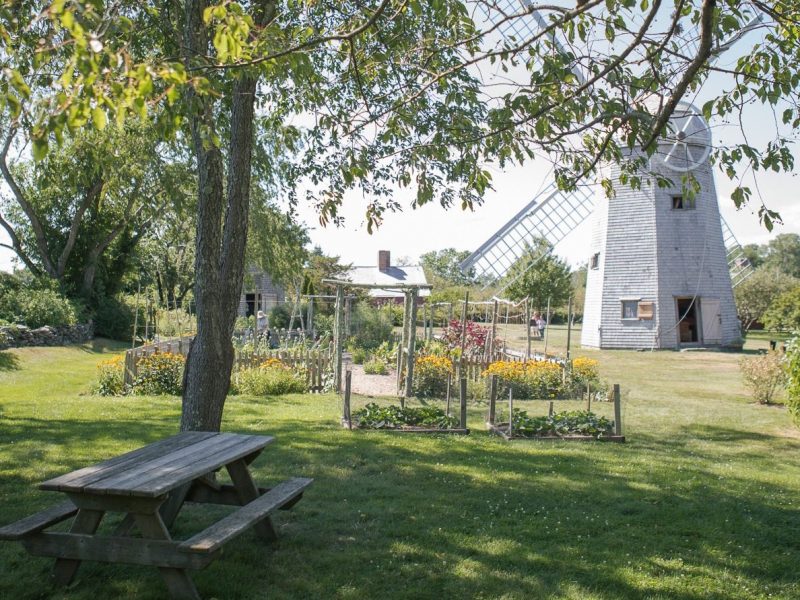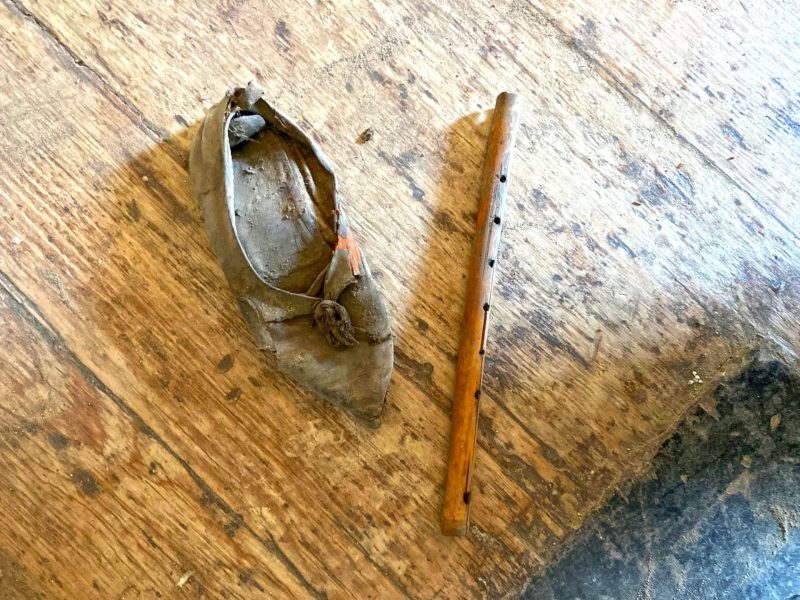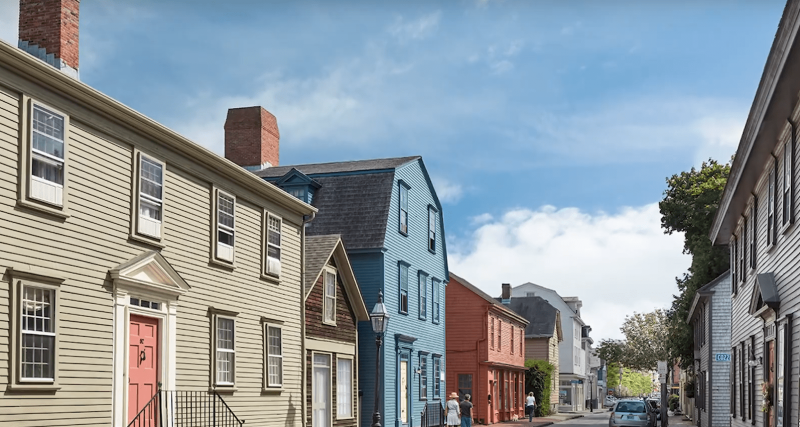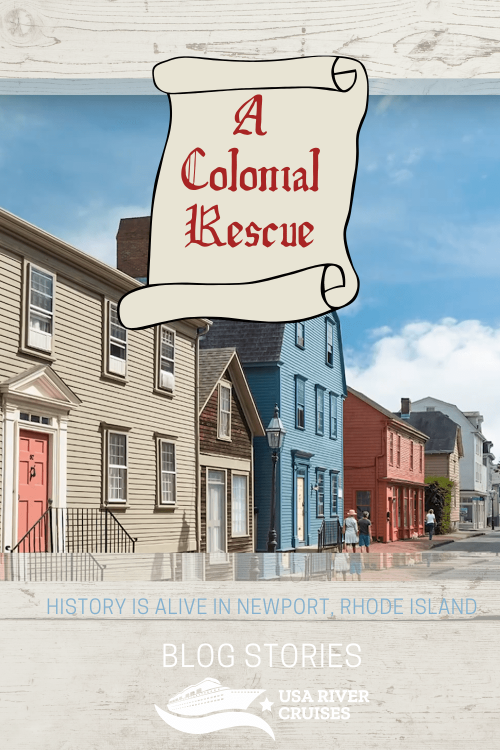
In Newport, Rhode Island
by Dawn Woolcott
When the homes are gone, much of the stories are too. In the early to mid 20th century, there wasn’t much interest in saving old buildings. The post WW2 space race left many cities feeling their age as they looked towards the future. How does a historic, fairly run-down collection of old homes compete with bright and shiny new suburbs? After years of neglect, transformations of large older homes into apartments, and a general feeling of “what old is old and what new is better” seemed the norm. In cities all over America, older homes were being scraped in favor of building new, more modern homes. Yet in Newport, Rhode Island, the trend was reversed with the force of one woman.
In 1969, wealthy philanthropist and preservationist Doris Duke created the Newport Restoration Foundation. Doris purchased property in 1969 to preservice a historic Revolutionary era home, but also to use as a place where historic buildings could be moved to if needed to rescue them from demolition. That place was the Prescott Farm. In a city known mostly for its opulent gilded age mansions of the rich and famous, Doris also wanted to rescue and preserve the older, every-day homes from earlier Newport.
Prescott Farm is a 40 acre colonial farm site located in Middletown, Rhode Island just 6 miles north of The Breakers. Doris Duke bought this property not just because it is a scenic country home, but because it holds an important story in our country’s history and was in danger of being demolished. During the American Revolution, the city of Newport was captured and held by the British forces. The house was confiscated and used as headquarters by the British General Richard Prescott. Troops were housed in buildings on the property. The General was arrested while in the house in the middle of the night by American troops led by Lt. Col. William Barton. The British General was taken to Providence, and soon part of a prisoner exchange for American General Charles Lee.
While Prescott Farm was eventually not needed as a resting place for many rescued homes, the property is free and open to the public where you can find a restored 1812 windmill, buildings used as troop quarters, and trails to walk. The period-appropriate gardens are tended by master gardeners growing produce typically grown in a Colonial era kitchen garden.
The Prescott Farm is a contrast to the gilded age mansions of the late 1800s which are a big draw of jaw-dropping quality and style. They are just as magnificent as the palaces of Europe and have often been used as settings for lavish film productions. But to get a fuller perspective on life in the late 1800s, you need to look beyond the mansions. Imagine if you traveled to Europe and they had torn down “The Shambles” in York, Anne Hathaway’s Cottage in Stratford-upon-Avon, or Anne Frank’s home in Amsterdam and replaced them with a grocery store? What a loss. Yes, we need grocery stores, but we also need our country’s history – of both the rich and famous, as well as the not-quite-so-rich and never-really-famous.
For five decades, the Newport Restoration Foundation has restored and preserved over eighty 18th and 19th-century buildings in the Newport area. Most are rented as private residences to carefully screened tenant stewards and maintained by a full-time crew of carpenters and painters.The homes are lived in, loved, and used as intended as they have been for over two hundred years. Several other homes are open to the public – those who love Colonial history, architecture buffs, and those who appreciate the value of history. A large selection of the homes can be found walking through the blocks of the historic district along William Street and Clarke Street or Touro Street and Mary Street.
Unusual items can be found inside old houses when restorations are underway. For example in the William Vernon house, they uncovered an old shoe and a wooden flute hidden in the wall behind the fireplace. It was an old superstition to hide a shoe in the wall to ward off evil spirits or bring good luck to the family. The long-held superstition was common in England and had been for many centuries. The earliest reported shoe was discovered behind the choir stalls in Winchester Cathedral in London, which were installed in 1308.
The historic district is one of those must-see areas when visiting Newport – to see an area that isn’t a living history museum – but a real area of the city brought back to life from the brink of extinction. The homes have been painted in historically appropriate colors – much more colorful than homes of today. Most homes had undergone additions and changes over the decades creating a quandary – which additions should remain, which should be removed? Decisions are made on a case by case basis – do you keep the cupola that was added in 1856 or remove it and take the house back to its original 1756 version? Which edition of the house is appropriate to save? 18th century? 19th century? 20th century? The challenges of restoring old homes are many, but the rewards are something we all can appreciate and enjoy. Wander through Newport’s historic district, and see if you can just imagine Thomas Paine or the British redcoat troops walking down the street. You just might feel our country’s history is still alive and well.
Learn more about the Newport Restoration Foundation and watch their interesting videos on their YouTube site.
You can visit Newport, Rhode Island on a cruise of the New England Islands:
New England Islands-American Star
Roundtrip Providence
- 7 Nights
- July 27, 2024,August 3, 2024,August 10, 2024--
6 more dates available. - From $5,145
- American Star
New England Explorer Cruise
Roundtrip Boston
- 10 Nights
- July 27, 2024,August 6, 2024,August 16, 2024--
3 more dates available. - From $7,350
- American Constitution






